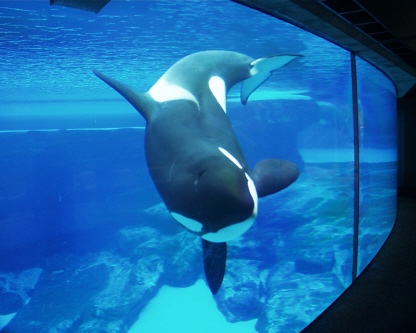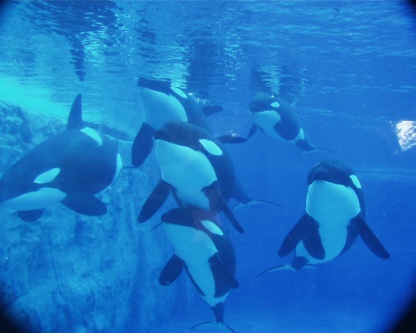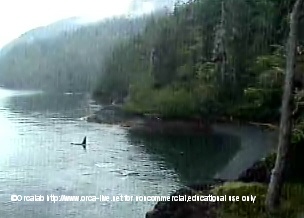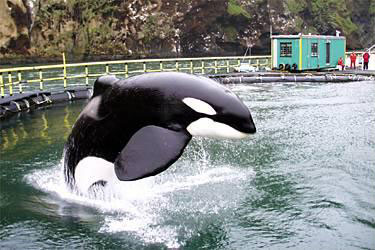

Time has changed our opinion of the orca drastically. Today, the orca is both more revered and in more trouble than it probably has ever been. The thing is, we are both the solution and the problem.
Where are they today? That's what this page is on.
In the Tank
There are currently, as of July 27, 2005, at 9:19 pm EST, 45 orcas in captivity. Also of that date, at that time, there are 12 places in the world holding orcas- 5 in the USA, 1 in Canada, 1 in France, 1 in Argentina, and 4 in Japan. I stated the time and date because this can change at any moment-orcas can die, leaving a facility without an exhibit, making one less orca and one less facility. This is because of the 12 marine parks, half of them, literally half, have only one orca. Considering these whales have the most evolved and complex social system possibly on the planet, who can justify keeping a single orca alone in a tank, no matter how huge and excellent the tank is, no matter how caring and loving the caretakers are?
Personally, I am against orcas in captivity. First off, I don't really see the point. Certainly, many people each year go to parks and are amazed at the amazing, beautiful animals. But just as many go and see them as nothing more than exhibits. Educational purposes, while interesting, don't stick. The children, the ones supposed to benefit from this, don't remember the facts when they leave. On a recent trip to a marine park, I heard kids say, "He's fat", or "They're ugly," or "They look dead". Not exactly encouraging. However, to be fair, I also saw one or two kids who fell completely in love with them.

1. NO MORE CAPTURES FROM THE WILD!
In this day and age, you would think that's a given. So did I! Until, amazingly, Russia captured a whale in 2003!! I know that Russia has issued permits to capture more whales and I think that's amazingly ridiculous. Canada and the USA and most likely other countries have put their foot down-personally, I think wild-captures should be illegal, because there is now a fairly stable breeding program, at least in the Sea World Parks, and if other marine parks want more orcas, they can breed them. There's no reason for the trauma and horror of captures.
2. An Attempt at Releasing Good Candidates
What I mean when I say 'good candidates' is whales that could probably readjust to the wild, despite decades in captivity. For instance, probably the best candidates, and the most strongly campaigned for, are Lolita, the lone survivor of the USA captures, and Corky2, the failed mother and lone survivor of the Canadian captures. The reason I believe these whales are the best candidates is simple-we know who their families are. Look at Keiko, the star of Free Willy, and his release back into the wild. While many skeptics say that, because Keiko continued to seek human company and didn't interact and travel with the other whales on a regular basis, the experiment failed, I disagree. I believe that the fact that Keiko could practically travel across the ocean, suffering only a bit of exhaustion, is excellent, considering the years and bad treatment he received in captivity. With more time, I believe Keiko could have completely gone back into Icelandic orca pods. Now, if Keiko's release could be a (debatable) success, don't you think, with proper training and lots of hard work, Corky2 and Lolita could be freed, if we knew EXACTLY the whales they were related to? Corky2 was probably Stripe's daughter. Sadly, Stripe has since died. But Corky's brother, Fife, her sister Ripple and her niece Midsummer live happily in the wild. Corky2 has listened to recordings of her pod's dialect, and her reaction was dramatic-she literally began to tremble. She clearly remembers them! Lolita is a member of the L-Pod-when played recordings of the L pod vocalizations, she swam over and leaned towards it, listening intently. I believe these two, with hard work and dedication, could be released, or at least moved to live half-freely in a bay in BC/Washington.

3. No Lone Orcas
This is certainly one of the most easily done and least expensive ideas to improve orca lifestyles in captivity. After all we have learned about their social structure, there really isn't any way to justify keeping orcas alone. Currently, 6 orcas live by themselves: Lolita, Shouka, Nami-Chan, Kshamenk, Ku and Asuka. Lolita has been by herself since the death of tankmate Hugo, in 1980. That means she's gone 25 years without contact with another orca! On the other hand, Shouka, a young female, lived with her mother, her half-brother, her dad, her brother and another female, until recently when she was moved to Six Flags in the USA, where she now lives alone.
I find it unacceptable to leave orcas to live alone. No matter how much love you give them, it doesn't make up for their family. Also, I believe that separating young calves from their mothers isn't very good, considering that they naturally stay with their mothers for life, although I do appreciate that this is usually because of tension between the two, or because the mother is pregnant.
4. Standards
Fairly simply, I believe there should be laws and guidelines, outlining what are the limits on the size of the tank, the amount of orcas, and what kind of care the orcas must be given. Some countries already have these laws/guidelines, but many do not. There are some marine parks that should, quite frankly, be shut down for abuse. On the other hand, some do the best they can to ensure their animals' care and safety.
In more recent times, captivity's had some startling developements. At Sealand of the Pacific, a young woman named Keltie Bryne fell into the water. The three young whales at the aquarium, Tillikum, Haida2 and Nootka4, were unused to people being in the water. They grabbed the screaming woman and 'played' with her until she drowned, in front of horrified onlookers.
Sealand closed soon after that, but incidents of violence didn't end. Years later, the same whale, Tillikum, was found with a dead, naked man draped across his back. The man, who had sneaked into SeaWorld at night and either jumped or fell in Tillikum's tank, was concluded to have died of hypothermia. Tillikum was not responsible for the man's death-in fact, Tilly, as he is affectionately known, is one of the gentlest whales in captivity. He has a tendency, however, of underestimating his strength-he is the biggest whale in captivity!

The last of the more graphic events was when Kandu5 and Corky2, two whales who didn't exactly get along, were in the middle of a show. Kandu5 charged at Corky, to the horror of the crowd. Amazingly, Corky was unharmed. Kandu, on the other hand, severed an artery. She was led into another pool and bled to death in front of helpless trainers. In an ironic twist of fate, Kandu's young daughter, Orkid, was adopted by Corky2.
The breeding idea, however, has been one of the happier aspects of captivity. Katina, the first orca to give birth in captivity and successfully raise her daughter, gave birth to four more calves after first-born Kalina: Katerina, Unna, Taku and her latest, Ikaika. Katerina, sadly, died at the age of 10. Kalina, however, also became a success, when on February 2, 1993, she gave birth to Keet and became the first captive-born orca to give birth. Amazingly she was only 8 at the time! Since then, she's had two more successful births, Keto and Skyla. To add to that, Katina became a grand-grandma, and Kalina a grandma, when on December 21, 2004, another whale named Kasatka had a female calf named Kalia. The father of this calf? None other than Keet!
Another first in the breeding aspect came in 2000, when Kasatka, an Icelandic-captured whale, became the first whale, and the first cetacean, to be artificially inseminated. This widened the gene pool considerably! On September 1, 2001, Kasatka's son Nakai became the first whale born through artificial insemination!
No doubt as the years progress, more and more births will result in happy, live, and healthy calves who will hopefully grow into healthy adults and who will have the chance to grow old.

Finally, I have to say that this is just my opinion! Don't take it COMPLETELY seriously-take it with a grain of salt or two! Most likely, the captivity issue is going to be around for a LOONGG time. Personally, I think that as long as they get their new orcas from breeding, although it won't be perfect, they're going to have a sort of cut-off community of orcas. A population of orcas with unique behaviours and relations with other animals, including us. I salute the trainers and caretakers, veterinarians and so on who take care of the whales-most of them love and care for the whales, know their personalities and take care of them meticulously. I hope that all marine parks can keep their animals healthy, happy, and safe, and I hope one day, orcas will die in captivity of OLD AGE.
In the Wild
Meanwhile, exciting and rather shocking happenings have popped up on the wild whale front.
Sadly, Dr. Michael Bigg died in October 1990. He is now known as the Father of Killer Whale Research-and rightly so! Thanks to him, you can buy a book full of the ID photos of every known whale in BC and Washington! Dr. Bigg has two whales named after him, appropriately! One young whale, G46, is named M.B. (Michael Bigg), while a Southern Resident, J26, is just called Mike.
Yes, you read right above. An ID book is now out. In fact, the second version came out in 1999, and from what Iíve heard, a third edition is in the making! Which is GOOD, considering that the whales have changed quite a lot in 6 years! Iíve been pestering the Vancouver Aquarium with emails, but they donít know the date yet-soon, hopefully!
Orcalab and Orca-Live are both going strong! Paul Spong and Helena Symonds now have many cameras, one above surface situated at Cracroft Point, and one at the Rubbing Beaches!
Speaking of the Rubbing Beaches, they were declared the first environmental reserve specifically for killer whales in the world! Fishing, firearms, boats, and pretty much access of any kind is strictly forbidden. Although they are thinking of making some way of non-intrusive observation. It is now called the Robson Bight (Michael Bigg) Ecological Reserve.

Erich Hoyt, a researcher who's been there since practically the beginning, wrote one of the best books you can possibly get if you're interested in orcas. Orca-The Whale Called Killer not only presents most of the facts on this website in a more interesting manner, but also tells fascinating and wonderful stories of the whales he, and we, come to know and love.
Alexandra Morton has also been busy. She's now written four books on orcas. A children's book called Siwiti-A Whale's Story is a charming book that's excellent for kids, as is her other children's book, In the Company of Whales: From the Diary of a Whale-Watcher. The second one is for older kids, but it's also a wonderful insight into her and the whales' daily lives. Listening to Whales-What the Orcas Have Taught Us is another one of the best books an orca-lover can buy, and Beyond the Whales is a beautiful book on the eco-system of the area.
Itís amazing just how dedicated the people of BC and Washington are to their whales! There are Ďadoption programsí for the transients, northern residents, and southern residents. For the Northern Residents and some transients, you can symbolically adopt a certain whale, or a whole family, from the Vancouver Aquarium Killer Whale Adoption Program. By paying a certain amount, you will get an ID book, an adoption certificate, and the newsletter, The Blackfish Sounder, depending on what deal you purchase. For the Southern Residents, you can symbolically adopt a whale through the Whale Museum Orca Adoption Program, at the fantastic Whale Museum in Friday Harbour, and you will receive a certificate, an update on the whale population, and their excellent newsletter, Cetus. For both of these programs, proceeds go to funding conservation and research efforts to help the killer whale.
New calves are now written up in the paper, with contests held to name them.


Talking about diving with orcas, remember all those people saying orcas were man-eaters, back in the beginning? Well, around then there were a lot of tales of orca 'attacks'. However, most of these attacks left no one hurt, and none of them could be proven as orcas. But there was one 'attack' on a human that WAS proven. Hans Kretschmer was 100 ft from shore in California, when a huge black shape nudged him, then grabbed him! Hitting it on the head, Hans bodysurfed to shore, where he received 100 stitches for the three wounds on his left thigh. Other than that, which was most likely a case of mistaken identity (like most shark attacks), the only signs of aggressiveness to humans are the captive orcas.
Finally, a recent project has popped up on the international orca front. Starting in 1999, the Far East Russia Orca Project, shortened to FEROP, found a small team of researchers identifying little-known killer whales in Russia's (you guessed it) far east. So far, to my knowledge, they have identified 150 orcas, all of which travel in close groups, feed on mackerel and have open saddle patches. Genetically, they are closely related to BC's residents. Meanwhile, they found a lone orca traveling close to shore, which was genetically close to the BC transients. This might be our first proof that resident/transient systems exist elsewhere in the world! We'll be watching the Russian project closely!
In the Public's Eye
Orcas have gone from being hated to being celebrities!
This part of this page will talk about the general opinion of orcas (these days-who knows, it could change!) and the celebrities that just happen to be black and white and have fins!
While everyone fell in love with Shamu and her many 'descendants', or Haida and Bjossa in Vancouver, or Kandu in Ontario, etc, the movie business decided to go with it. Heading down to a small marine park in Mexico, they found a huge male orca named Keiko. They filmed him for a movie that was about a beautiful whale befriending a boy and then being freed into the wild. Then they left him and he was forgotten-but Willy wasn't. Free Willy came out and became a (surprise) smash hit. I did a recent survey of people I know, and to my astonishment, everyone had seen Free Willy-it was just a part of growing up. Of course everyone had heard of it. Who would've expected it? A movie about a whale, of all things.
Meanwhile, poor Keiko was alone in a small pool in Mexico, losing weight and developing a skin condition. When the public found out that he actually wasn't freed, they went ballistic. An international effort was launched to free Keiko. As the Free Willy Foundation would find out, freeing a killer whale wasn't as simple as letting him jump over a cliff. Keiko was sent to Oregon, where he was trained to be a wild killer whale. And then, he was gradually released into the wild waters of Norway. It was a half-way success. Keiko interacted with other whales occasionally, but he was a little (understandably) confused. However, he traveled 1,600 km away, showing no worse for the wear, except possibly being a little tired. But he was still seeking human friends, so his caretakers moved him into a bay, where they continued getting him more used to the wild. Keiko was hunting by himself and living a semi-wild life when he died of pneumonia in December 2003. He was buried next to the bay where he died, and his grave was visited by hundreds of schoolchildren.


Finally there's Luna. Luna has become a bit notorious recently. Also a young whale separated from his family, Luna's story isn't exactly the same as Springer's. Luna, for instance, isn't an orphan. He's older, and he's healthy, living happily and hunting successfully. He's been living successfully alone for five years now. There's a lot of debate on what to do about Luna, because a reunion might not help him right now. However, as he grows, more and more problems are going to pop up. Luna has started causing trouble with boats, getting a little too friendly, and sometimes going to the point of harassing. And the humans can get a bit out-of-hand as well. And a full-grown male orca hanging around boats is not a good idea!
We'll be watching Luna to see what happens. And in the meantime, we can be proud of the one-in-a-lifetime effort that gave Springer's story a happy ending.
It's an amazing evolution process, our opinion on the orca. Where we once shot them without thinking, decades later we clamber onto boats and cheer them. Where once we trapped them in nets and took their children away, we establish reserves and fine people for harassing them. And in the tanks that have killed literally hundreds of whales, we raise them and their children as home-bred star attractions. What must they think of us? Do they think of us at all, or do we not warrant any interest? But the gentleness, kindness, and curiosity whales like Stubbs, Springer, Corky and the others have shown towards us say they do think of us-and somehow, despite all our attempts to eliminate them, they don't want revenge. Have we changed to much? Are we too extreme about our treatment of them? Maybe we are, maybe we aren't-time will tell.